Tim Shaw grew up in Manchester, Massachusetts, and summered on Cuttyhunk Island, the end of a chain of small islands west of Martha’s Vineyard, so his childhood was steeped in traditional wooden boats. In his tween years he got his first taste of boatbuilding when a friend on Cuttyhunk built a sailing pram and, soon afterward, he looked on as his father built a pram for the family. As a teen, Tim sketched small boats inspired by traditional forms. During the summer after his freshman year at high school, his parents gave him the okay to build a Gloucester Light Dory in the space that had been his playroom when he was younger. When he went off to college, he thought he’d become a yacht designer, but an unpleasant math class in the first semester brought that ambition to an end. For the next decade, Tim turned his attention elsewhere.
When Tim married, he and his bride, Lisa, went to Hawaii for their honeymoon and during a walk on a beach on the coast of Kauai they saw an outrigger canoe. “I was instantly transfixed by the blend of modern and traditional,” he recalled, “and, despite no experience with such a craft, I decided this was the sort of boat I needed to have.”
The couple moved to Alexandria, Virginia, and there Tim was able to begin gathering boatbuilding skills at the Alexandria Seaport Foundation during Tuesday open-shop evenings and at the Apprentice for a Day program at the Chesapeake Bay Maritime Museum in St. Michaels, Maryland. He also spent a week at WoodenBoat School taking a class in boat design, reconnecting with the vision he had once held for his future.
In 2006, Tim came upon plans for the Peace Canoe, designed by John Harris, in a “Getting Started in Boats” insert in WoodenBoat magazine. He didn’t have a shop, so he built the canoe in his side yard, often working by headlamp after his young children, Helena and Aidan, had gone to bed. The canoe was a success, but it didn’t fulfill his dream of building an outrigger canoe. He began sketching variations of the ocean canoe and departed from the decked OC1 (single outrigger canoe) he’d seen in Hawaii toward a more traditional open canoe.
At first, he had strip-built construction in mind, but after reading Robert Morris’s book, Building Skin-on-Frame Boats, Tim was drawn to the materials and construction of a lashed framework. With that as his goal, he spent months drawing the lines and construction details.
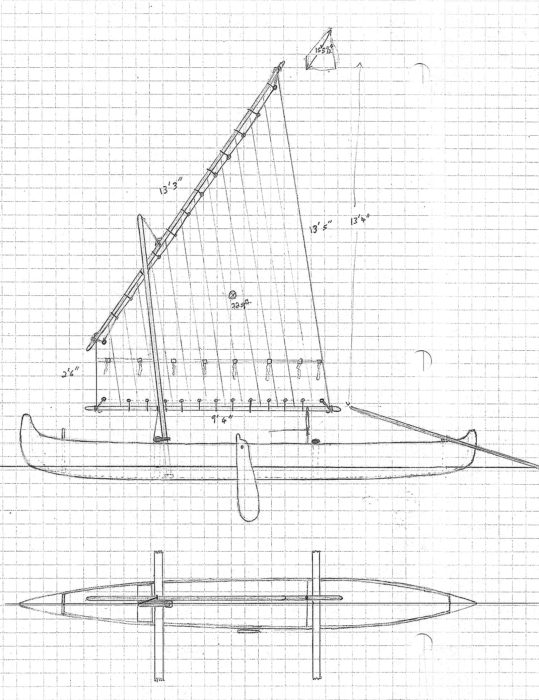 Photographs courtesy of the Shaw family
Photographs courtesy of the Shaw familyTim approached the design of his outrigger canoe with neatly drawn, detailed sketches.
In 2009, he began the construction project by building the outrigger, or ama. Tim carefully selected dimensional lumber from a big-box home improvement store and resawed it to produce the ama’s longitudinals—the keel, chines, gunwales, and deck. They were given their shape by a stem piece, three bulkheads, and a small transom.
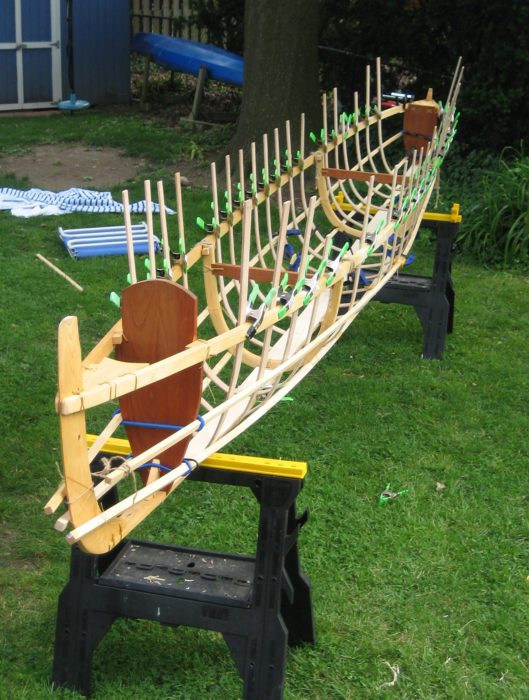
The steam-bent ribs all went into the main hull in a single day of steaming in the back yard.
Artificial sinew served as the main fastener and some dowels used as trunnels reinforced critical joints. The finished ama was covered with a nylon skin made watertight with a two-part urethane coating. The main hull, called a kino, was of similar construction, but with steam-bent white oak for most of the frames. Two stout laminated frames provided the attachment points for each crossbeam, or ’iako.
Tim launched the canoe in the fall of 2010 and christened it AL DEMANY CHIMAN to acknowledge the design’s influences: Al is “the” in Arabic, demany is “sail” in Malagasy, and chiman is “canoe” in Algonquin.
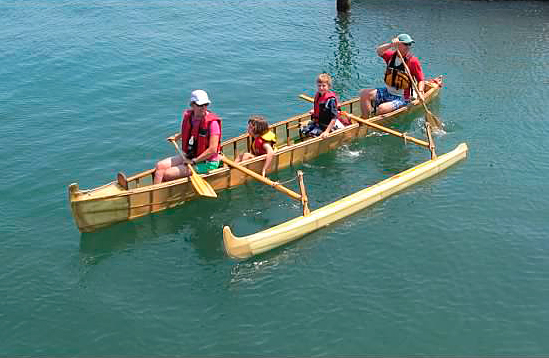
On one occasion, the Shaws took the canoe to Cuttyhunk Island, where Tim had spent many summers while growing up. From bow to stern: Lisa, Helena, Aidan, and Tim.
AL DEMANY CHIMAN did not yet have her sailing rig, but paddling served well for family outings on Chesapeake Bay. During a five-day solo cruise on Muscongus Bay, Maine, Tim observed that she “handled the more open water well and proved light enough to carry ashore on the rugged islands. It was a voyage I had dreamed about in the boat I had made reality.”
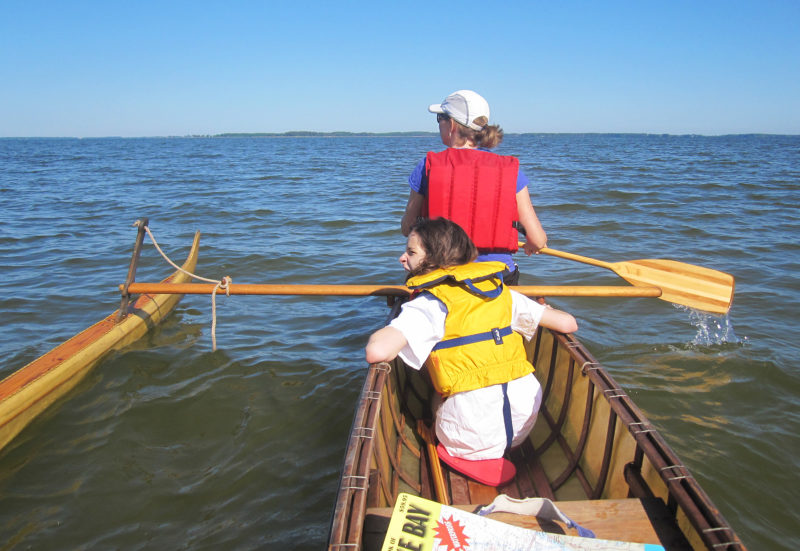
The first version of the ama was skinned and plagued with a persistent leak. Here, in 2011, Lisa paddles at the bow while Helena scans the Chesapeake Bay waters off Queenstown, Maryland.
Helena and Aidan took a liking to the canoe. On an outing in the fall of 2011, Helena came up with the idea of hanging from one of the outriggers while her father paddled. Aidan wasted no time in joining the fun and slipped overboard to hang on an outrigger, too.
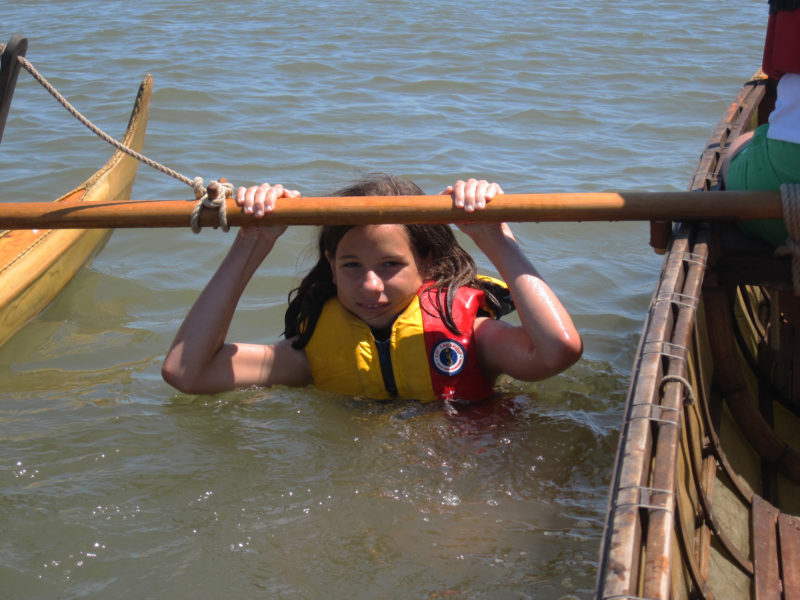
Helena came up with the idea of hanging from one of the ’iako. It made for slow paddling but making good speed was never the point of the family outings. Here, she cools off in the Patuxent River.
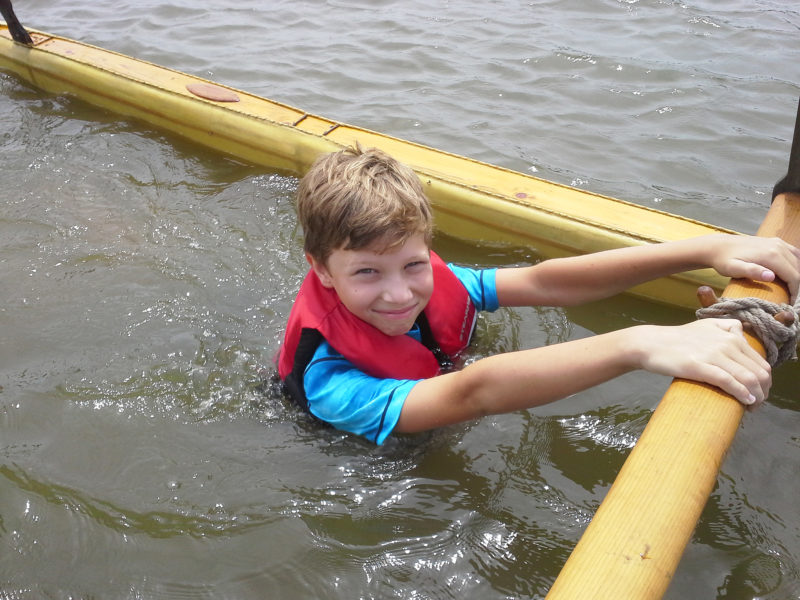
Aidan wasn’t about to miss out on the ’iako hanging. He’s trailing a turbulent wake.
Not everything with AL DEMANY CHIMAN went as expected. The ama took on water no matter how much caulk Tim applied to potential leaks. For safety’s sake, Tim removed the skin, carved pieces of foam to fill the space inside the frame and put on a new skin.
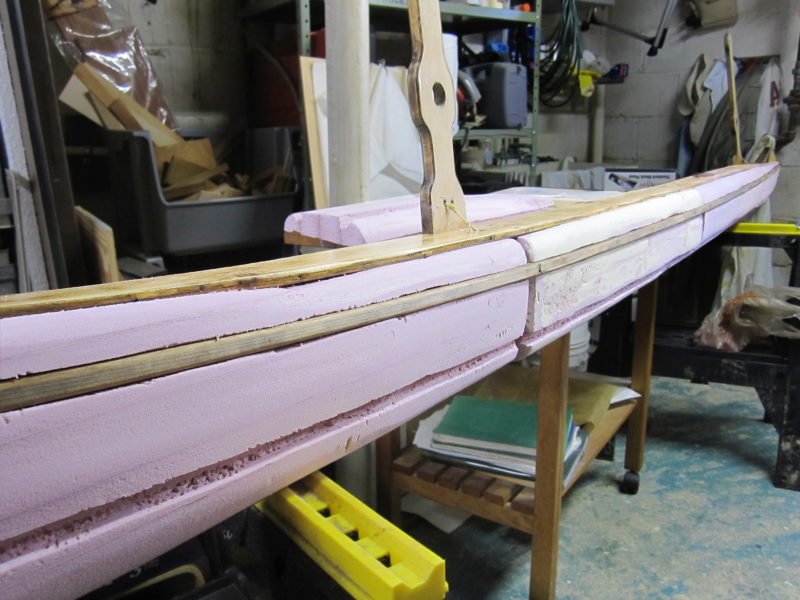
Stymied in his efforts to find and stop the leaks in the ama, Tim changed tactics and filled it with carved blocks of foam.
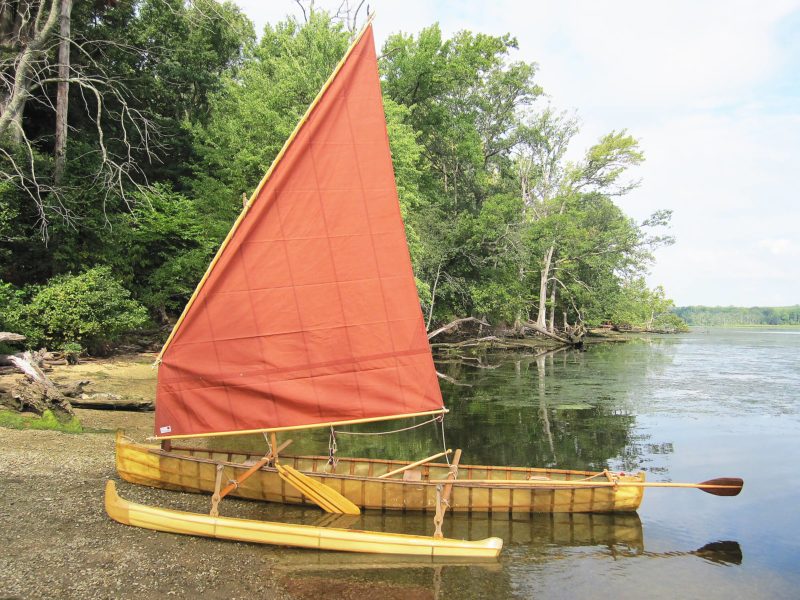
Tim put a lot of effort into the sailing rig, but AL DEMANY CHIMAN didn’t take kindly to it and her main hull twisted with the torque imposed by the mast.
He also discovered that the sail applied enough torque to the frame to twist it alarmingly out of shape, so he chose not to press his luck and used the canoe without it. “AL DEMANY CHIMAN has thus been almost exclusively a paddled canoe,” Tim notes, “but I have been very happy with her in this capacity.”
In the autumn of 2014, Tim and Helena went for a father-daughter paddle on the upper-tidal Patuxent River in Maryland. Helena, who is on the autism spectrum, was engaged in the outing and settled in the stern seat, enjoying the river’s marshes. Unfortunately, as Tim recalls, “it would prove to be the last paddle of its kind.”
Early the next year, Helena went swimming at the local rec center and suffered a seizure while underwater. The pool lifeguards quickly pulled her out of the pool after which she coughed up a lot of water and then seemed well enough to go home. There, her breathing became labored, and Tim and Lisa made calls for an ambulance. At the hospital, Helena suffered heart failure, a result of a dry drowning—her lungs had been damaged by the water she had aspirated. Helena survived, but the lack of oxygen had injured her brain. She remained in the hospital for 15 weeks, but has not fully recovered her mobility or language.
“After adjusting to the new normal, I turned my attention to ways to get Helena more active.” Tim wrote. He built her a wheelchair that could negotiate trails in the woods during the summer and a kicksled for winter outings.
“What I really wanted, though, was to get back on the water more, and I wanted to bring Helena.” Paddling AL DEMANY CHIMAN was something they could do together, largely unhampered by the new disabilities. In 2019, Tim added a second ama to give the canoe stability on both sides and built a seat that would give Helena the support she needed.
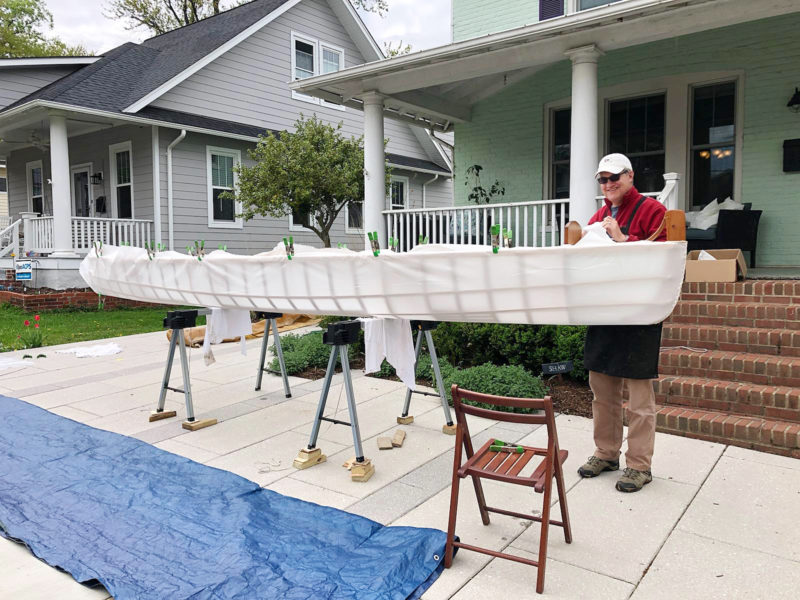
In 2021, Tim gave AL DEMANY CHIMAN a new skin.
AL DEMANY CHIMAN was showing her age. Some parts had significant rot, others were broken. In 2019, Tim rebuilt the ama, and over the winter of 2020, he completely rebuilt the main hull and gave it a new skin.

Twelve years after she was first launched, AL DEMANY CHIMAN takes to the water again as good as new and with a new smaller outrigger to starboard. From the stern, Tim, Helena, and Aidan.
AL DEMANY CHIMAN was relaunched in July 2021 and on the day following the launch Tim, Helena, and Aidan went paddling at Mason Neck State Park, situated in a backwater of the Potomac River about 17 miles downstream from Alexandria. The renovated canoe worked well and the three enjoyed the outing. They’ve been on many more since then. “AL DEMANY CHIMAN has given me not only the experience I had hoped for,” wrote Tim, “but also many lessons. She has proved to be a vehicle—and metaphor—for perseverance and renewal.”![]()
Do you have a boat with an interesting story? Please email us. We’d like to hear about it and share it with other Small Boats Magazine readers.

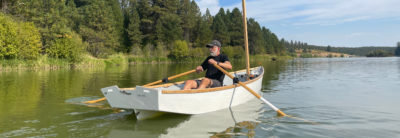
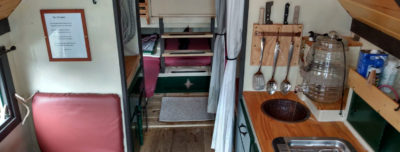


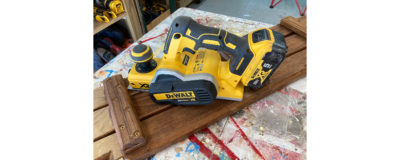
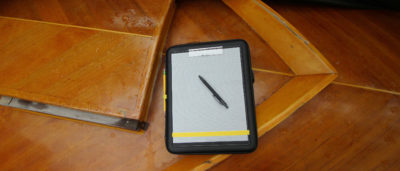
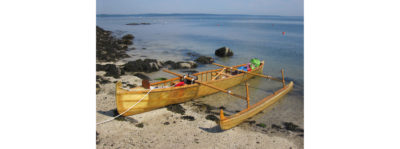

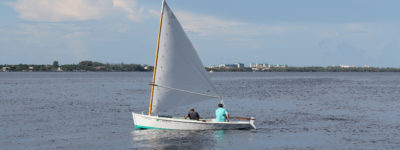

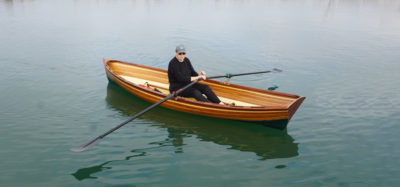
Great article! I have had a dream of building a proa. The more I read about skin-on-frame version, the more I get motivated. Thanks!
Phil Bolger has plans for a proa in one of his books.